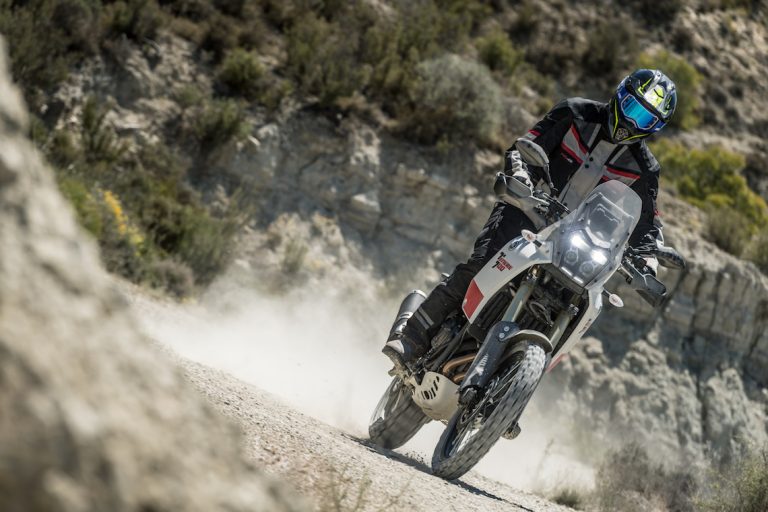Julian Challis heads to Spain for the hotly-anticipated Yamaha Ténéré 700 review
The stakes could hardly be higher. After a wait of over two and a half years and following a seemingly endless series of prototype reveals, public appearances, world tours and teaser videos, the moment had finally come.
Almost five years since the demise of the outgoing incarnation, the XT660Z, Yamaha was at last ready to launch the successor and continue the 36-year heritage of Ténéré.
Yamaha had not underplayed the importance of the occasion, basing themselves at an imposing medieval castle in Catalonia for the event and flying in a team of designers, engineers and product specialists from the European headquarters, not to mention a fleet of pre-production bikes that sat sparkling in the morning sunlight above the sprawling city of Tortosa.
At the press conference the night before, the presentation had been flawless and the mood confident, but would the bike live up to the expectations and the hype? Had the wait been worth it?
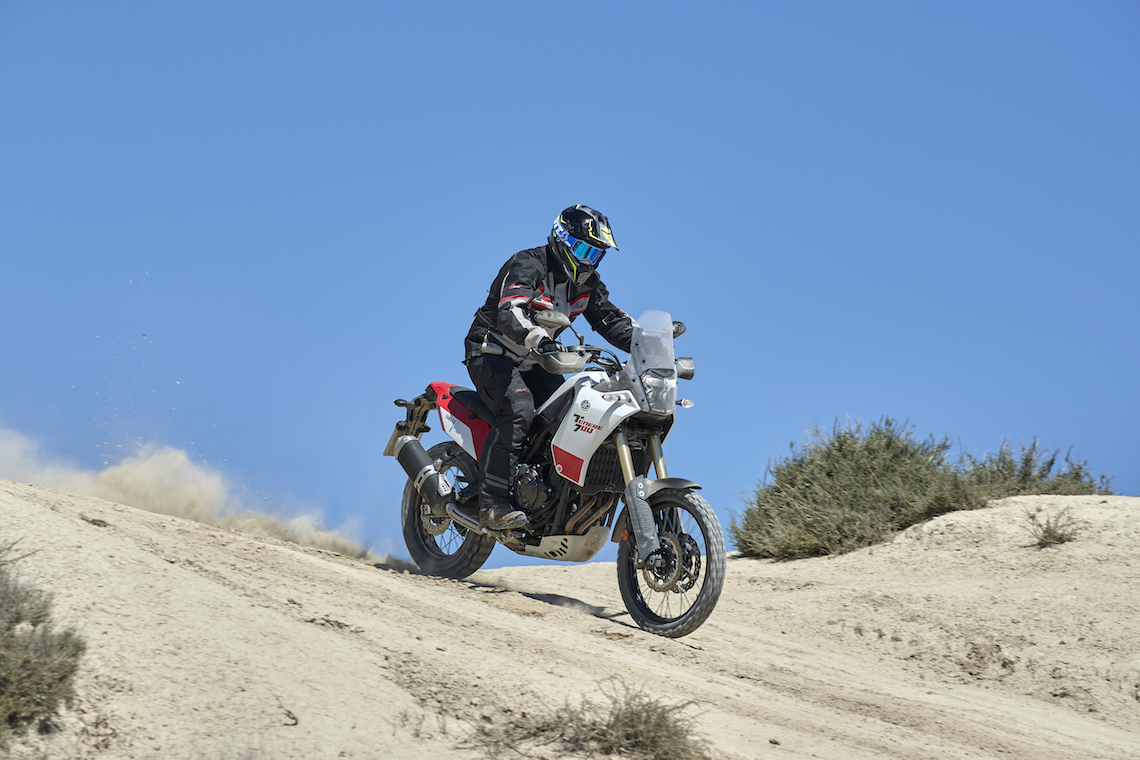
Delivers on every level
Within minutes of leaving the castle walls and dropping down into the city streets below, we knew the answer – the new Ténéré feels like everything we had wanted it to be. Over the course of two days and more than 300 miles of riding on everything from flat out blacktop to technical trails, this motorcycle delivers on every level.
Yamaha has managed to combine everything we liked about the old Ténéré and improve it while at the same time eliminating all the faults and quirks that the bike was infamous for. Just like the perfect pint of Guinness, good things come to those who wait.
But to understand how it’s taken so long to get to this happy conclusion, we have to go back a few years. The last remake of the Ténéré happened back in 2008, with the now-familiar praying mantis-style face looming over the 660cc single-cylinder machine.
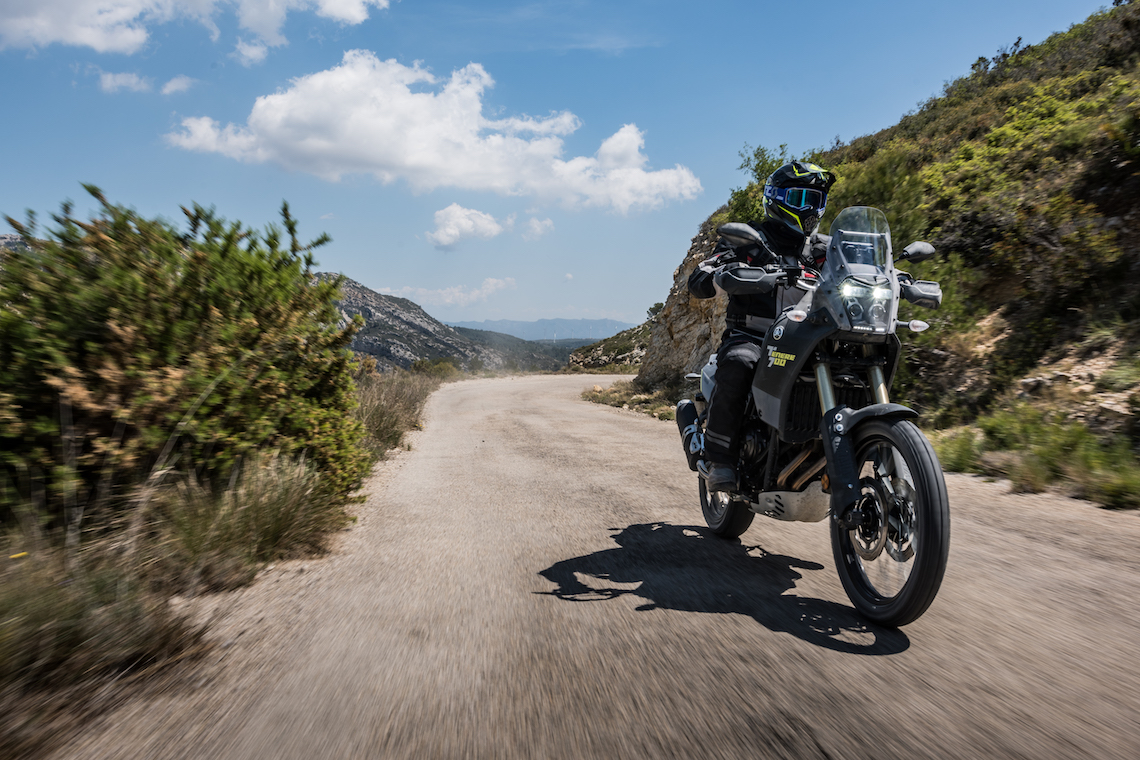
Legions of fans
With few comparable bikes on the market at the time, the Ténéré was popular with adventure riders and, despite its lamentable suspension, high centre of gravity and often lumpy power delivery, the XT660Z attracted legions of fans across the world.
But the bike had fallen foul of Euro 4 regulations and, bizarrely given the direction of the motorcycle market, Yamaha simply dropped the model from the range, the company’s sole competitor in the burgeoning adventure sector being the heavyweight XT1200Z Super Ténéré.
The manufacturer’s attention had been far more focussed on the road market with the development of what has turned out to be the hugely popular MT series. When the MT07 and 09 were launched, their incredible low price and aggressive styling made them instant showroom successes. The new crossplane engines, the CP2, CP3 and later the CP4 proved to be both powerful and extremely reliable – the 689cc parallel-twin CP2 motor having achieved the accolade of being the most reliable on the market according to consumer surveys.
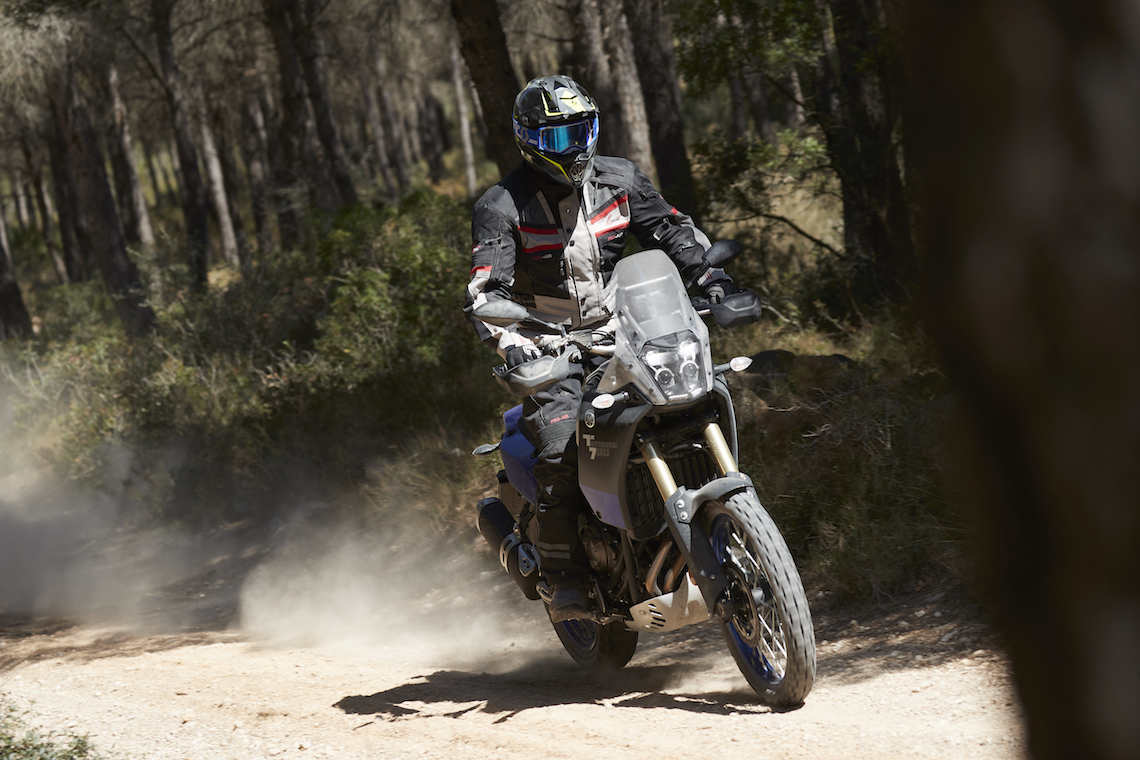
First impression
With such a capable engine and a gap within both the market and Yamaha’s lineup, the decision to combine the two was inevitable. In late 2016, the very first T7 Ténéré prototype was revealed at the Milan show. Some 30 months later, the Ténéré 700 is finally here and, in fairness to Yamaha, it looks surprisingly similar to the initial prototype shown at EICMA.
OK, according to the design brief, the new bike had to have the DNA of the long line of previous Ténérés, and you’d have to say that between the teams in Italy and Japan, they’ve got it spot on. From the high and upright screen at the front and the wide handlebars to the swoop of the seat and the narrow back end, the bike wears its heritage proudly – it couldn’t be anything else.
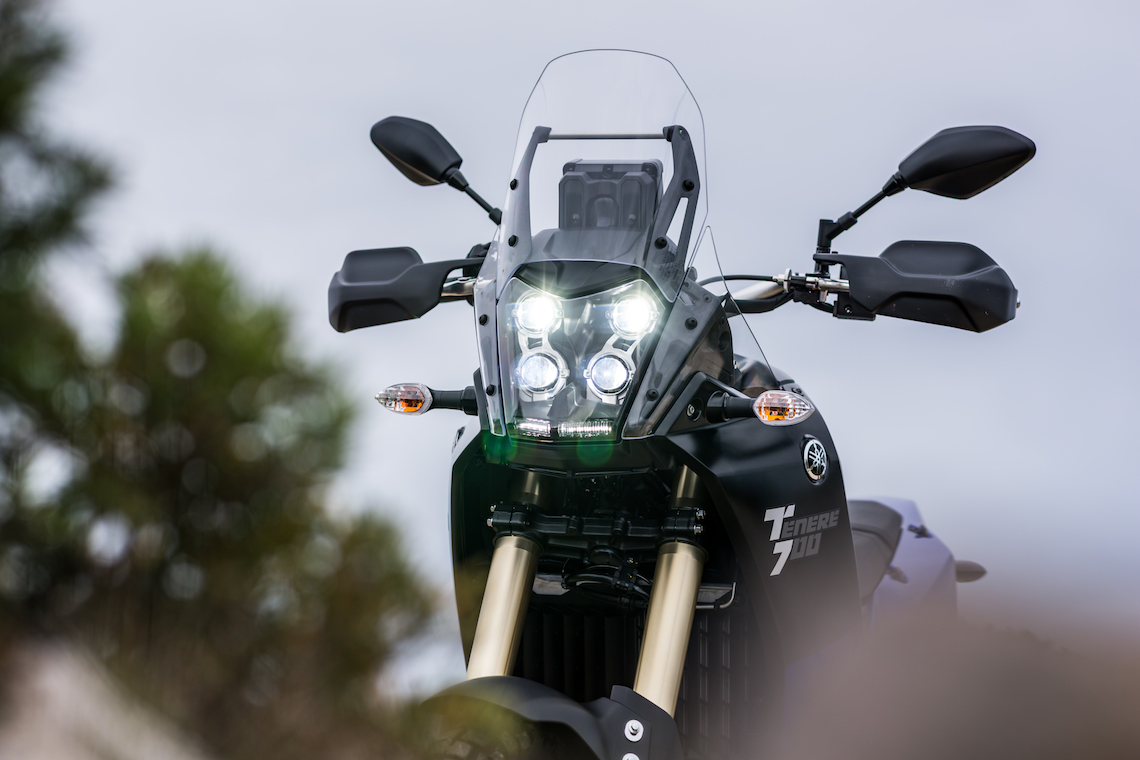
Colour options
Although most of the advance coverage of the bike has centred around the blue liveried option, or Ceramic Ice to give the official name, it’s the white and red one (Competition White) that stands out from the crowd, echoing iconic colour schemes from Yamaha’s racing past in both road and off-road racing. If that’s too showy for you, the Power Black colour variant looks suitably mean and moody, with only the logos and a flash of yellow and grey to detract from the stealth look.
Whichever colour option you choose, the bodywork is pleasingly minimal, rather than there being acres of heavy and ‘expensive to replace’ fairings and cowlings – this looks like a bike you can drop on or off-road without needing a mortgage to repair.
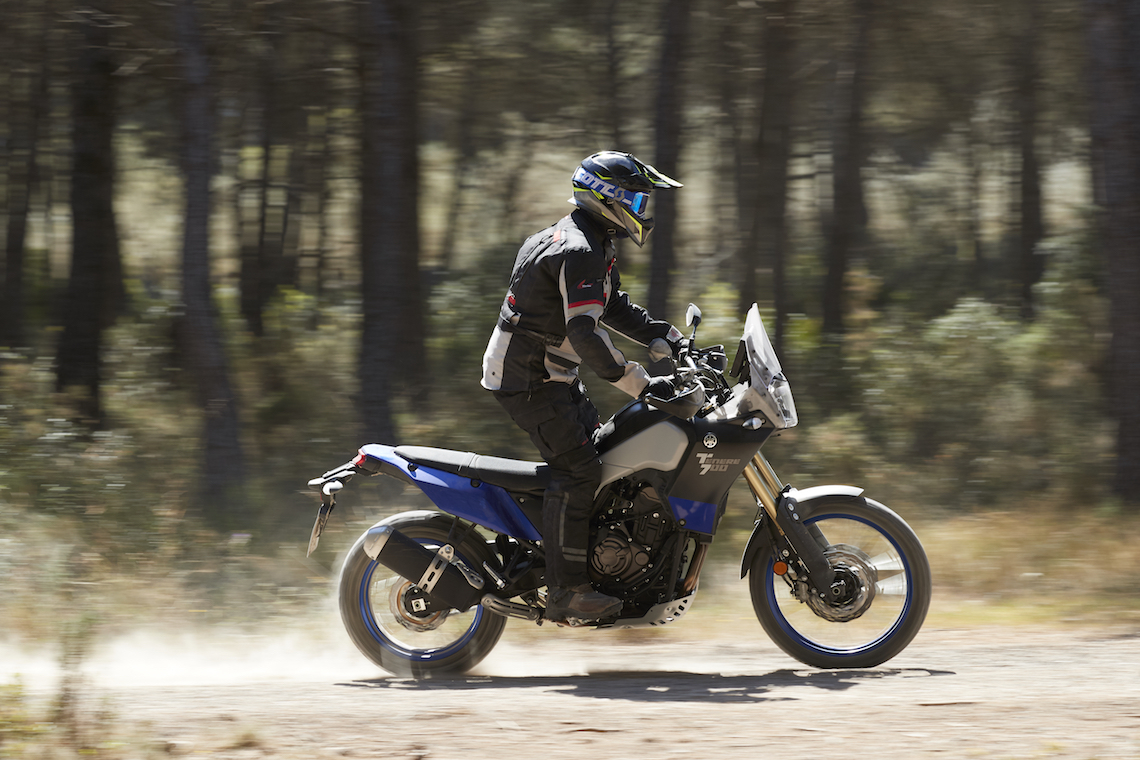
Focus on essentials
Yamaha’s intention was to produce a bike that was focussed on the bare essentials that matter for a true off-road capable adventure bike and that’s exactly what it’s done. From the uncomplicated, manually adjustable suspension to the complete absence of any electronic rider controls save for basic ABS, there’s a simplicity and clarity about the 700 that is very appealing. If you want a show pony then look elsewhere, the new Ténéré is as it always was, a capable and functional workhorse.
For the first part of the test, we left the confines of Tortosa and headed out to the north of the city, swiftly picking up fast-flowing and sweeping roads that head up towards Xerta and the National Park of Serres de Cardo-el-Boix. The motor on the Ténéré is almost identical to that within the MT 07, save for a new airbox, altered cooling system, slightly updated fuel injection and, of course, a new upswept exhaust that mirrors those on the bike’s Dakar winning ancestors.
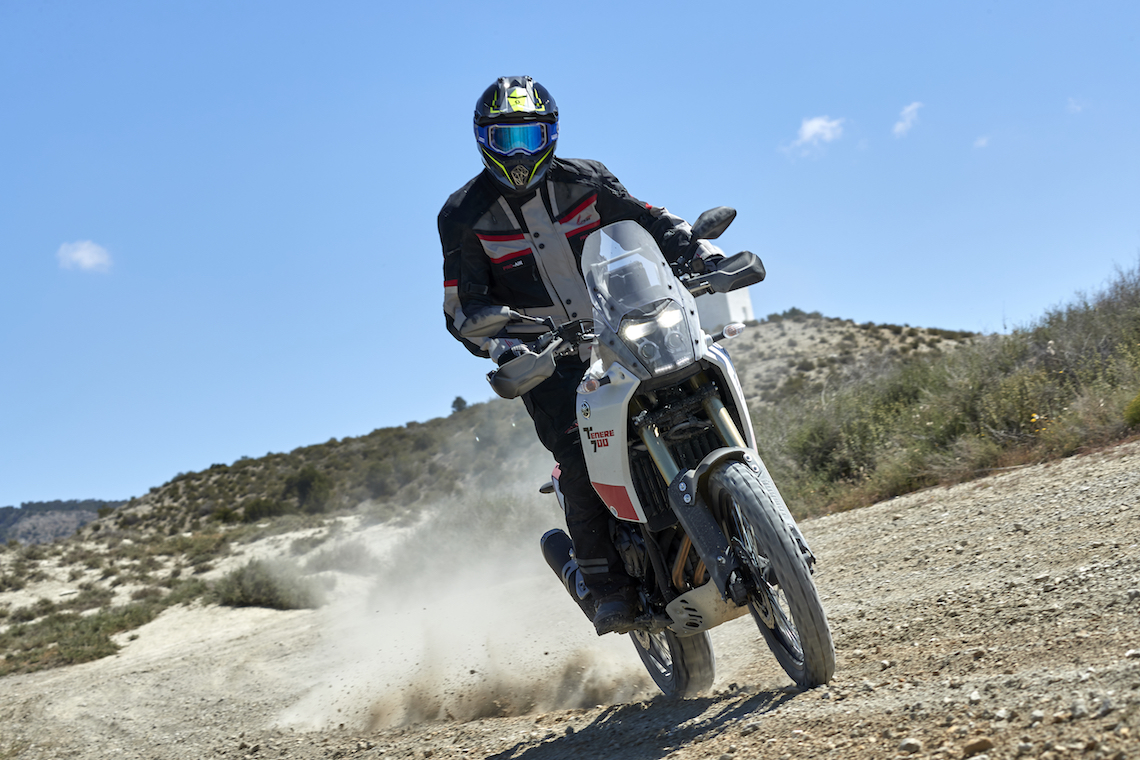
A joy on the blacktop
On the blacktop, the engine is a joy to use with an incredibly direct throttle response that reacts effortlessly to everything from gentle riding to licence threatening foolishness. The crossplane firing order from which the motor gets its name has the two pistons firing at 270 degrees and then 450 degrees later, the resulting effect being a far cleaner torque curve, reduced vibration and, perhaps just as importantly, an incredibly addictive rasp from that fat end can.
The motor might only develop just over 70 horsepower, small potatoes compared to the big beasts in this class, but when every single one of them is usable, it makes for a life-affirming riding experience. The riding position is well balanced with the tall stance giving a great view of the road and the small screen and front-end design offering surprisingly good wind protection for those of average height. Taller riders might be looking for the optional wind defector extension, but even without, the screen still does a good job.
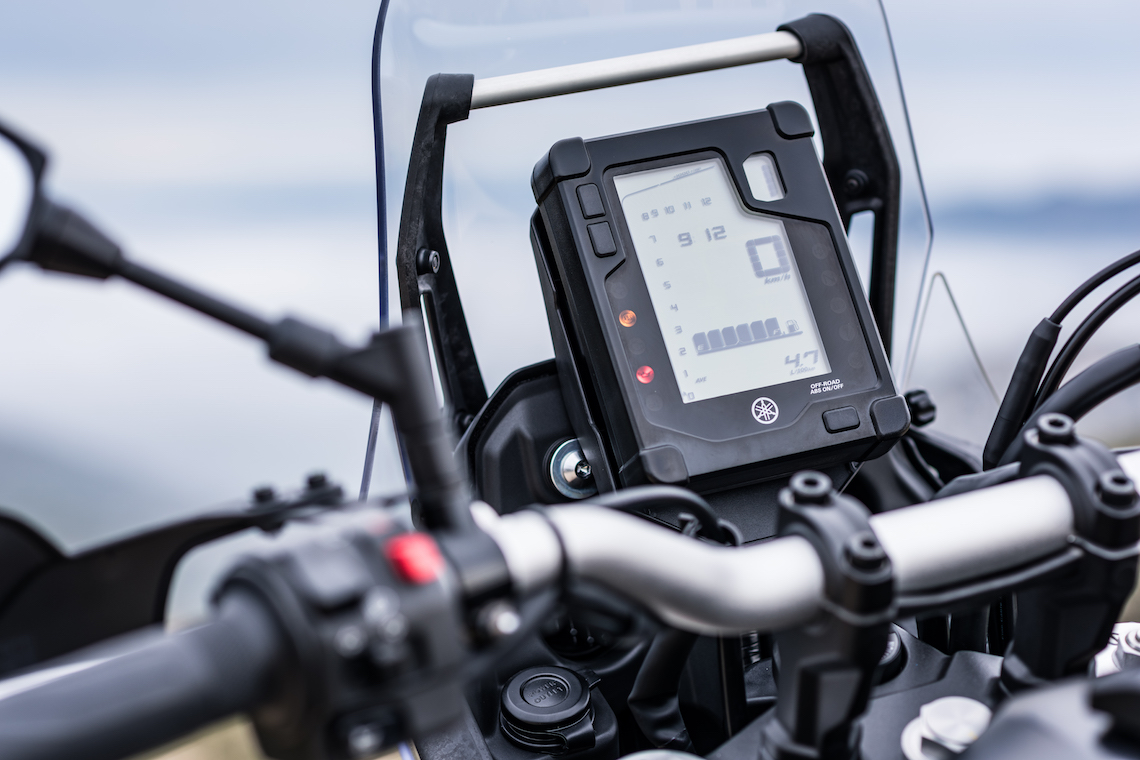
Minimal switchgear
For the clocks and switchgear, Yamaha has kept to the minimal and stripped-back design brief, with the vertically-mounted LCD unit displaying all the information you need from the tacho display that runs around the left-hand edge, with a digital speedo over the block style fuel gauge. Other than this, you get a trip meter, fuel range, fuel consumption, engine temperature and ambient temperature – all the usual suspects – that can be toggled from the right-hand switchgear.
In the top right, a gear indicator with a selection of the usual idiot lights either side of the display. Over the top of the speedo unit there’s a useful crossbar for mounting GPS, phones or cameras with one 12v outlet already in place at the base of the dashboard, with space for a second one should your technology habit require it.
Our route took us away from the faster roads and up towards higher ground through mile after mile of tight and twisty hairpin bends. Considering the bike comes fitted with dual-sport Pirelli Scorpion Rally tubed tyres on the off-road standard 21’ and 18’ wheels, the grip and feel is truly impressive and keeps the bike stable and planted regardless of the lean angle – a good thing when the drop-offs beside the road were getting more and more extreme.
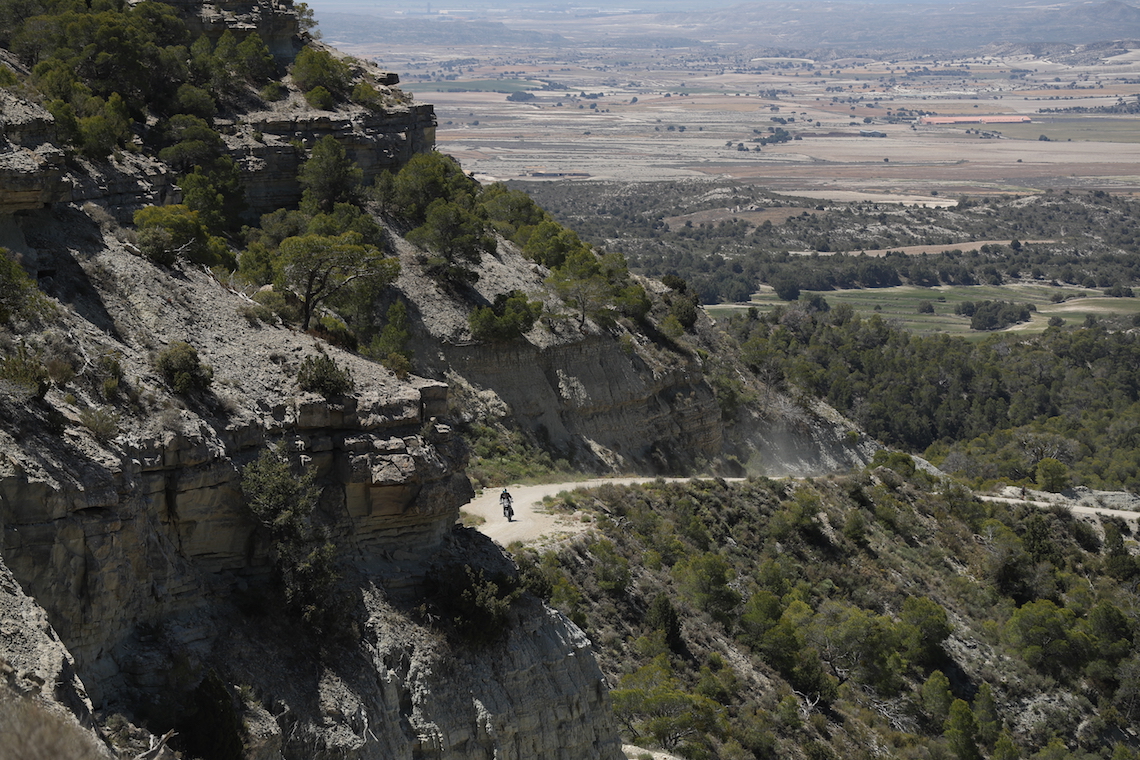
Exceptional suspension
The suspension too, performs exceptionally well given that it’s specced to fit the often very different requirements of on and off-road riding. Upfront, there’s a pair of 43mm USD KYB forks which can give up to 210mm of travel and are adjustable for both compression and rebound damping, the only other adjustment being the addition of an air bleed screw – something that will be familiar to dirt riders, but probably a complete mystery to road jockeys.
At the rear, it’s a familiar link mounted KYB shock with a piggyback reservoir that offers the 200mm travel and has similar adjustment for compression and rebound. There’s also a preload adjuster that can simply be turned with your hand to alter the spring, a beautifully simple solution that lacks any of the vulnerability and complication of electronic suspension systems.
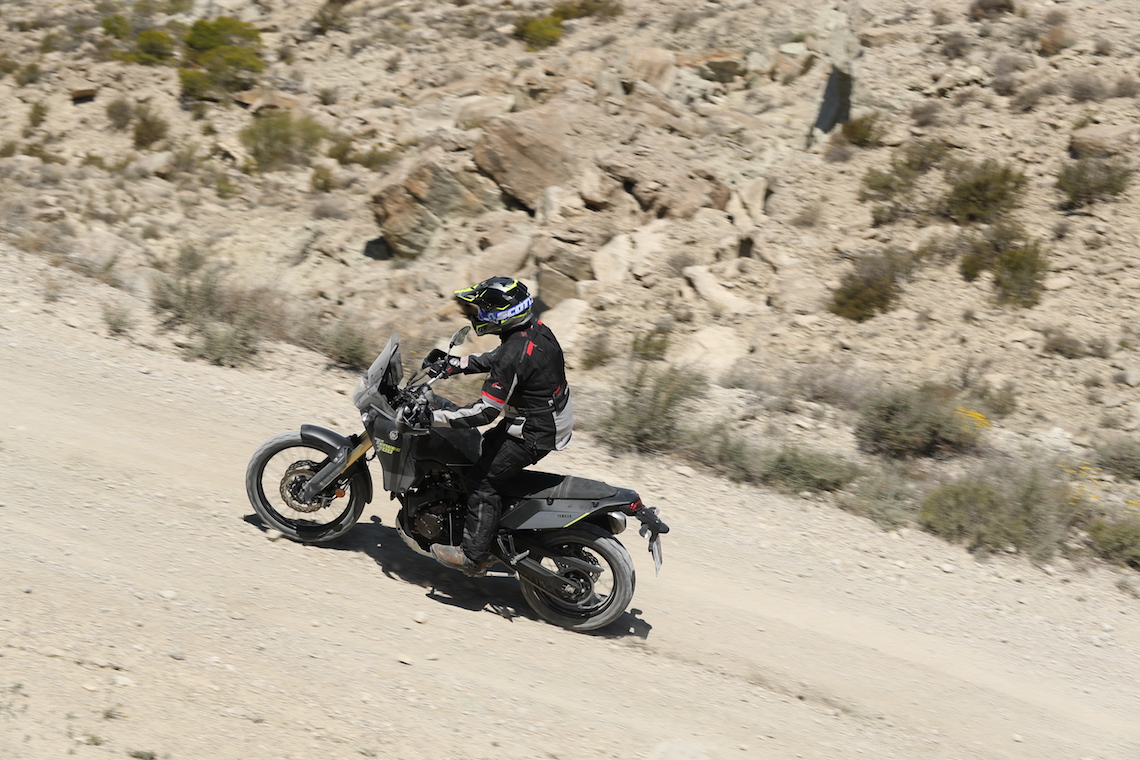
Buttery smooth gearbox
We continued for a glorious forty miles on the tarmac, with the Ténéré’s super-sweet engine and buttery smooth gearbox continuing to impress. Although lacking any of the quick-shift technology that is becoming obligatory on every adventure bike, the Ténéré tolerates clutchless changes going up and down the box, provided that you momentarily roll off the gas, and rewards you with swift and positive shifts every time. The torque of the CP2 motor does mean you can be a tad lazy as it will happily pull a gear higher than you expect, or if you are feeling a bit more of a hooligan you can cane the motor without a murmur of complaint.
With the sun rising in the sky and burning off what little clouds were left, our guide hung a left away from the main road and we stopped momentarily to regroup before heading out onto the first dirt section. The Ténéré comes equipped with ABS at both ends as the current regulations dictate, but at the bottom of speedo there’s a button that allows you to turn it off. Somewhat inconveniently, you have to be stopped to effect this change. When your route takes you on and off the trails (as green laning in the UK often does), this could prove a bit of a pain if you like ABS on the road but prefer it off when on the rough stuff.
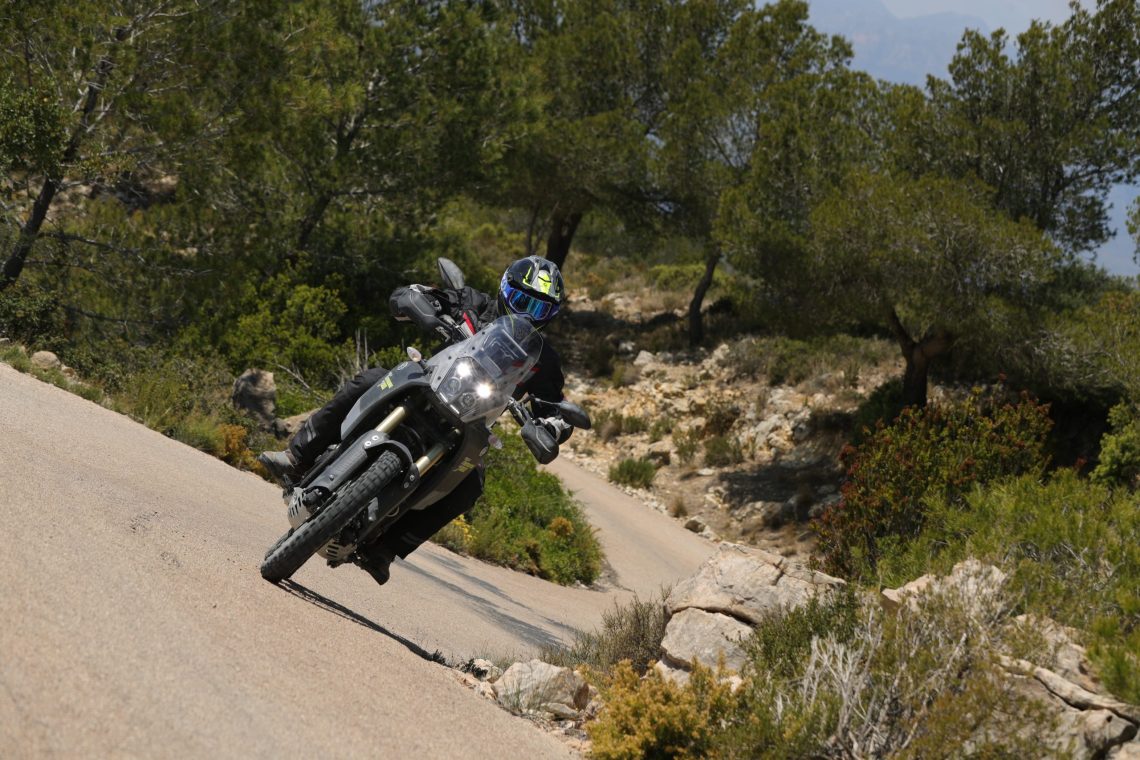
Trail Time
With the ABS deselected, we set off to follow a beautifully sweeping and joyful trail that would take us to the south of Gandesa. The transition from seated to standing is an easy one thanks to the well-thought-out geometry of the bike, the relationship between footpegs and bars being ideal for off-road riding.
You do initially notice the clutch cover sticks out a bit further than you’d perhaps want, but it soon fades from your mind. The footpegs have soft rubber inserts that isolate any vibration on the road, but quickly compress to reveal the toothed surround that grip your boots well and allow plenty of feel for weighting the pegs through the turns.
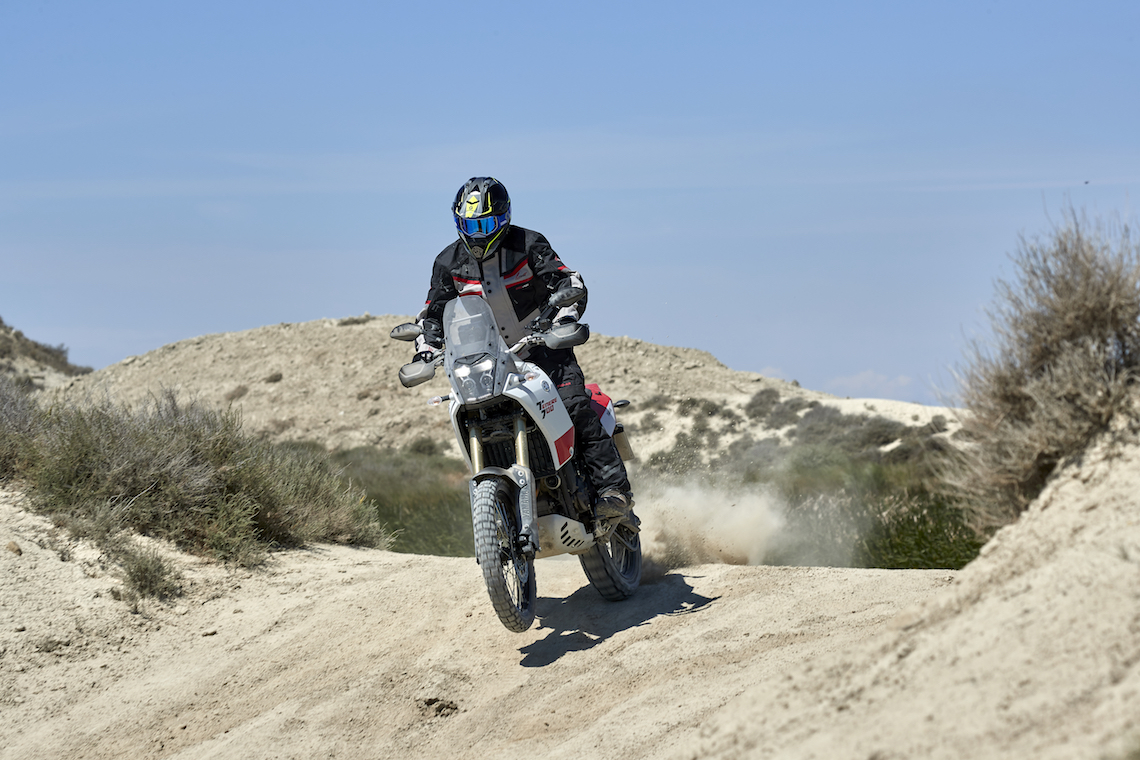
Subtle yet effective braking
The brake pedal is sensibly large, and with a Brembo caliper pulling on the 245mm disc, it offers surprisingly subtle and effective braking, from dragging into the corners to a full lock-up when required. At the front of the bike there’s a set of twin discs, just like the old Ténéré, the chunky 282mm rotors matched to a set of conventional Brembo twin pot calipers.
Whether on or off-road, the front brakes on the Ténéré are a stand out feature, combining both delicate action in the first part of the lever movement with faultless stopping power if required. And with the suspension so much better than the outgoing model, you won’t find yourself plummeting forward on heavy braking. Progress indeed.
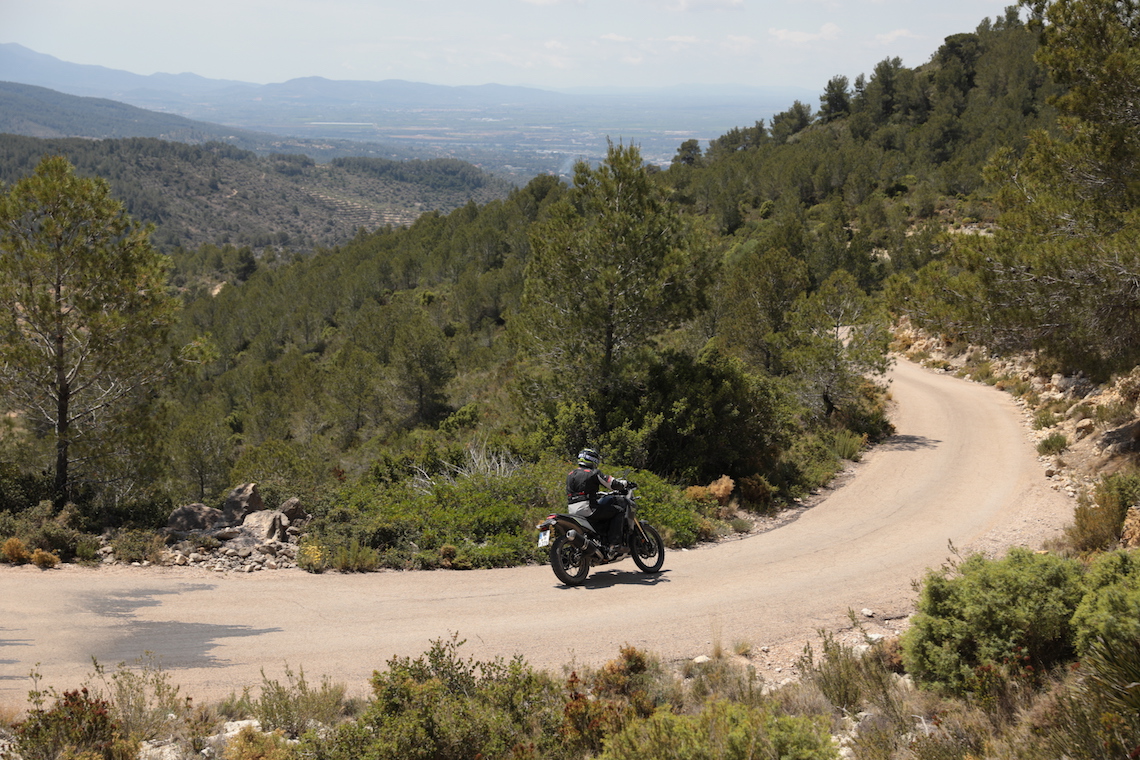
Balanced and poised
Following the trail for the next hour or so gave a chance to thoroughly assess the balance and poise of the new 700, and again it was ticking the boxes all round. Although many were hoping, perhaps unrealistically, for a bike that would tip the scales at well below the 200kg mark, the T7 comes in at 187kg dry and 204kg fully fuelled and ready to go – pretty close to the 2008 incarnation of the bike.
Yet, unlike the previous version, the designers have managed to centralise that weight and improve the balance and feel of the bike immeasurably. OK, it will still feel pretty heavy if you have to pick it up six times an hour in the mud but keep it sunny side up and the new Ténéré feels light, agile and eminently capable off-road. For seasoned off-roaders, this will be a massive selling point and for newcomers to adventure riding, it makes the prospect of venturing off-road infinitely more achievable and enjoyable. And with an A2 version available, you don’t even have to wait until you have a full licence!
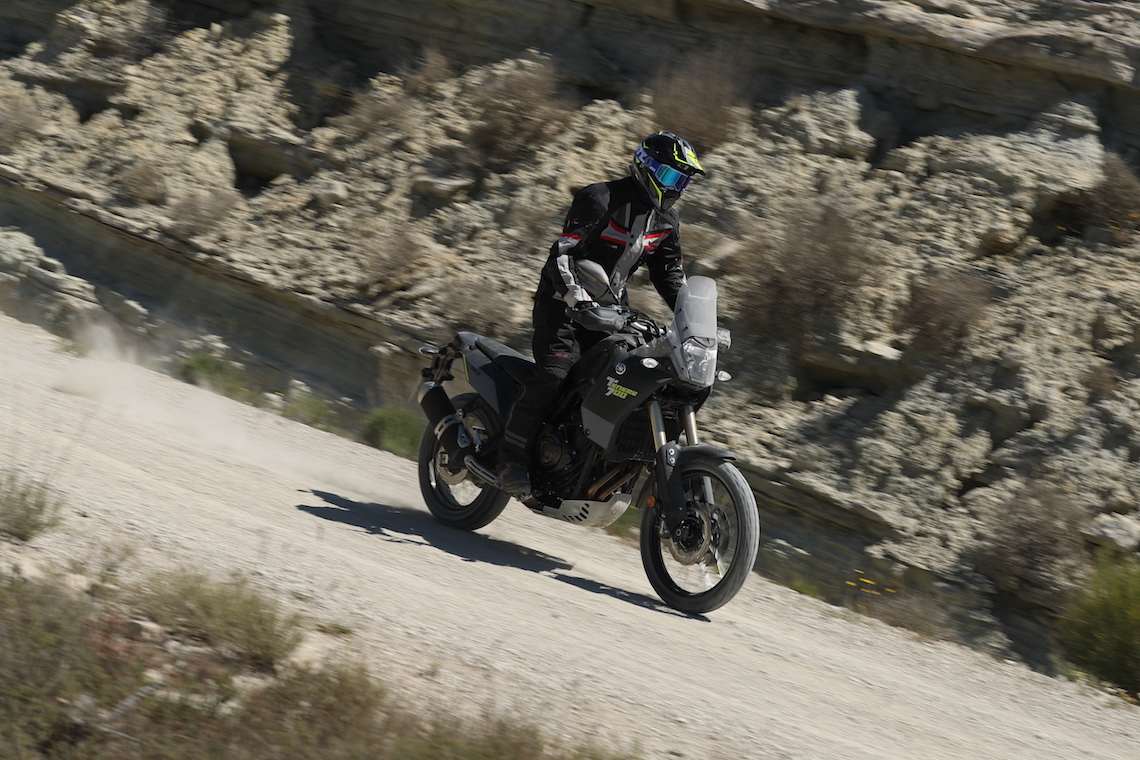
In the Frame
Getting the balance and feel of the bike appears to have been one of the main challenges for the designers of the Ténéré, and one that extended the development period of the new machine for longer than they might have hoped. Unlike KTM who developed the motor at the same time as the frame for its 790 Adventure and Adventure R, the Ténéré team started with the existing 700cc engine and have had to design the bike around it. You might think this would make the process much easier and quicker, but evidently not.
The problem is that the CP2 motor is tall, with the clutch held high and similarly the output shaft is almost halfway up the engine. Trying to make this work for an off-road platform, rather than the intended road use, required the frame to be totally redesigned, with the YMRE (Yamaha Motor Research and Development Europe) team coming up with a diamond frame in high tensile steel with a double-braced headstock that arches over the top of the motor.
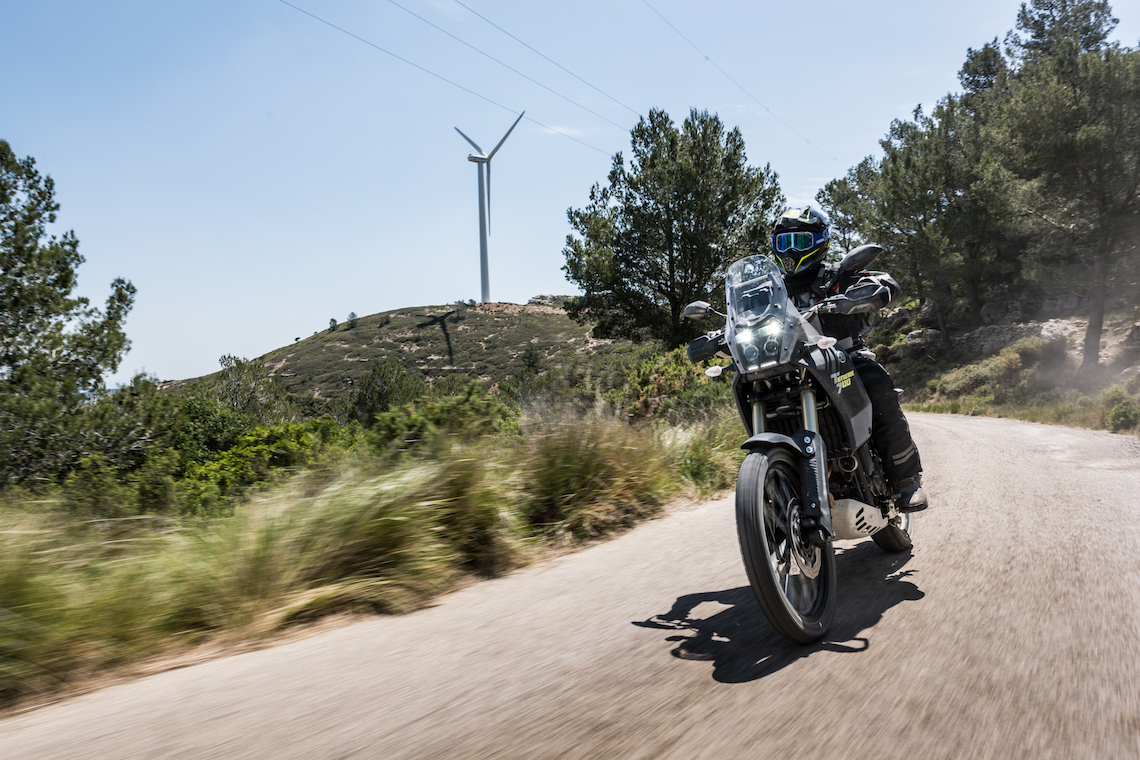
Lightweight frame
Also, like the KTM, the motor is a stressed member and is integral to the strength of the frame, thus reducing the overall weight of the machine as the frame comes in at a staggeringly light 17.75kg. The Ténéré does have down tubes that appear to cradle the front of the motor, but these actually have no structural function whatsoever and serve only to protect the front of the engine and provide a suitable mounting point for the lightweight aluminium sump guard.
At the rear of the bike, there’s a substantial rear subframe, essential for taking the additional weight of pillions and luggage that will hopefully form part of the Ténéré’s daily duties, and there are already luggage options available as aftermarket accessories or part of the Explorer package, one of two special packs available as dealer options or aftermarket purchases. Even without reaching for the accessory catalogue, all bikes are fitted with four useful luggage hooking points, further evidence that the design team have thought about how this bike will be used.
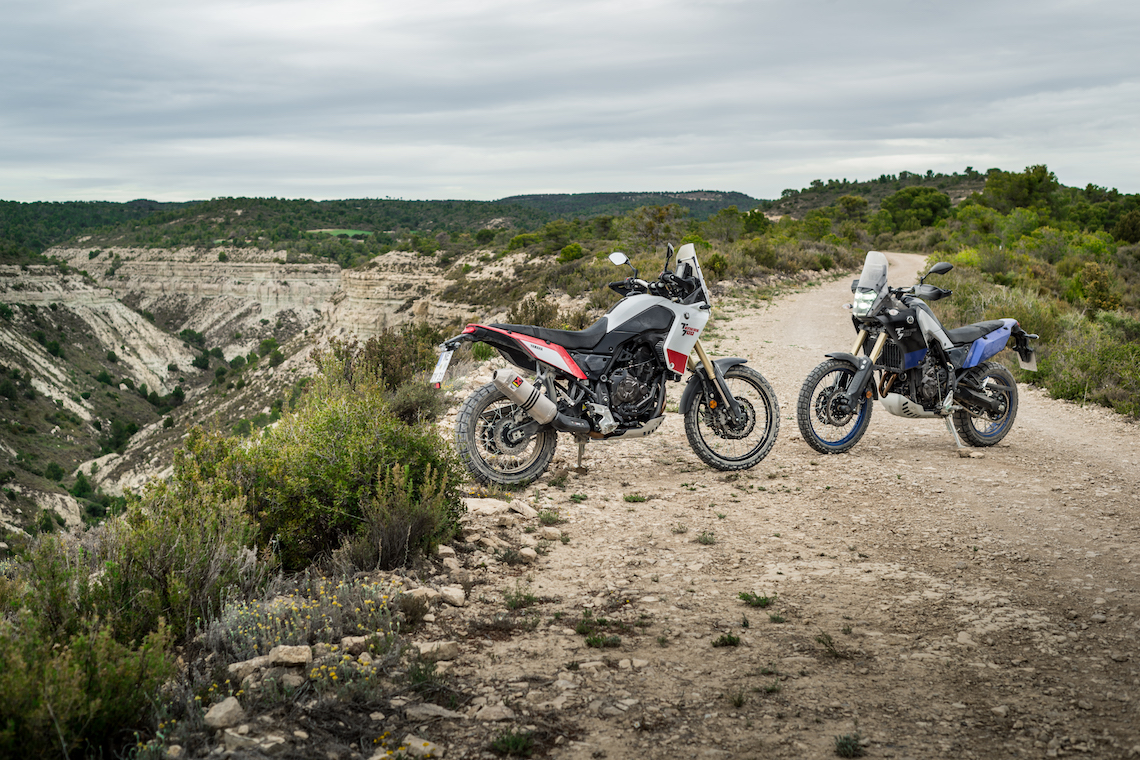
Technical riding
After an enjoyable 20-or-so miles on the dirt, we crossed over a narrow dam on the river Erbo and stopped for coffee just outside the town of El Dique to the north of Caspe. The bikes got a chance to cool down as did the riders, but before long it was back to the tarmac for a brief spell before we were on the dirt again. This time we were climbing away from the valley floor and the trails were getting more technical, with rock steps, loose gravel and sand sections to concentrate the mind and test the bikes.
The new T7 just soaked it up without breaking stride, keeping to the selected path with a dogged determination that is as confidence-inspiring as had been promised on the introduction the night before – it’s really quite difficult to get this bike out of shape. The Pirellis grip well, the suspension handles everything from big hits to stutter bumps without passing the impact to the rider, and with the riding position keeping your head directly over the bars, it’s a beautifully rewarding bike to ride and ride well.
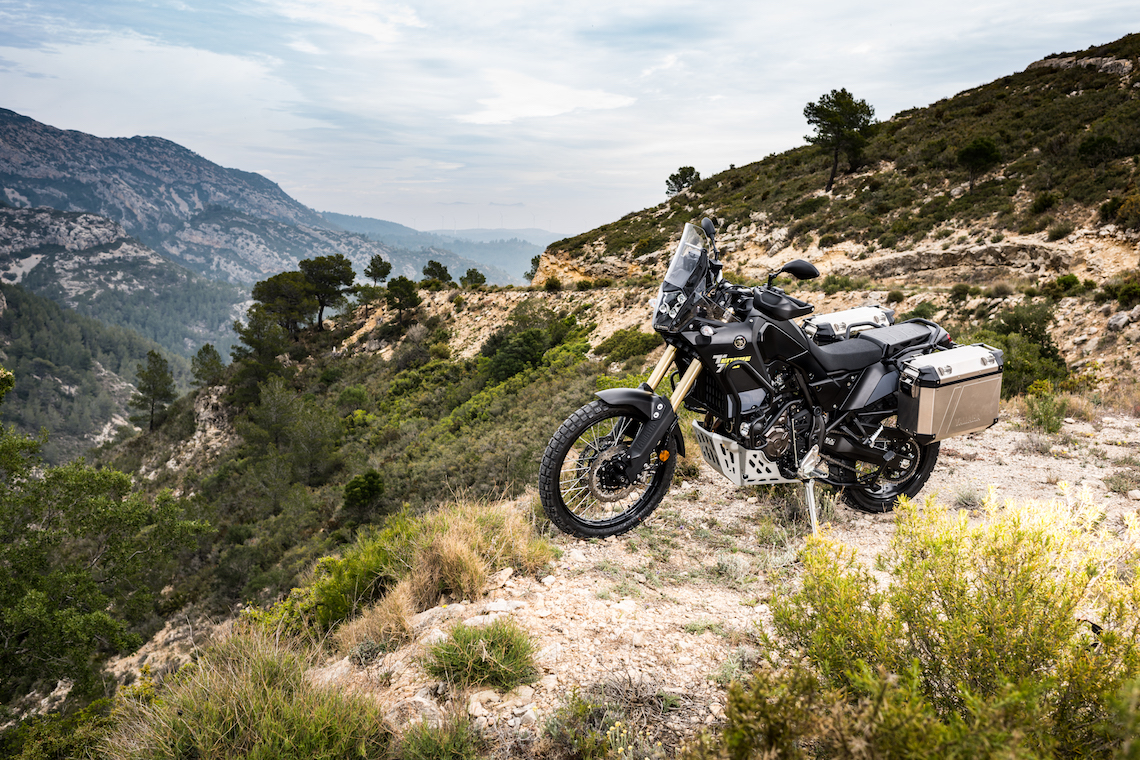
Low seat option
Of course, if you do find yourself at odds with the scenery, the standard seat height at 875mm is not too tall as to be intimidating and allows you to get yourself back on track with the minimum of drama thanks to the useful grab handles under the rear of the seat. If you are short of leg or indeed just prefer a more manageable seat height, there’s a low seat option that will remove a hefty 35mm, and lowering links are available to take down the rear of the bike.
As we dipped down again towards the low plains and our lunch stop, we picked up a long straight and beautifully surfaced road that simply begged for maximum speeds to be tested. We are happy to confirm that the Ténéré 700 will reach just under 120mph if pushed yet remains as stable as it was at 70. For a tall adventure bike on dual-sport tyres, that’s an impressive figure and shows just how good the CP2 motor and new framework together.
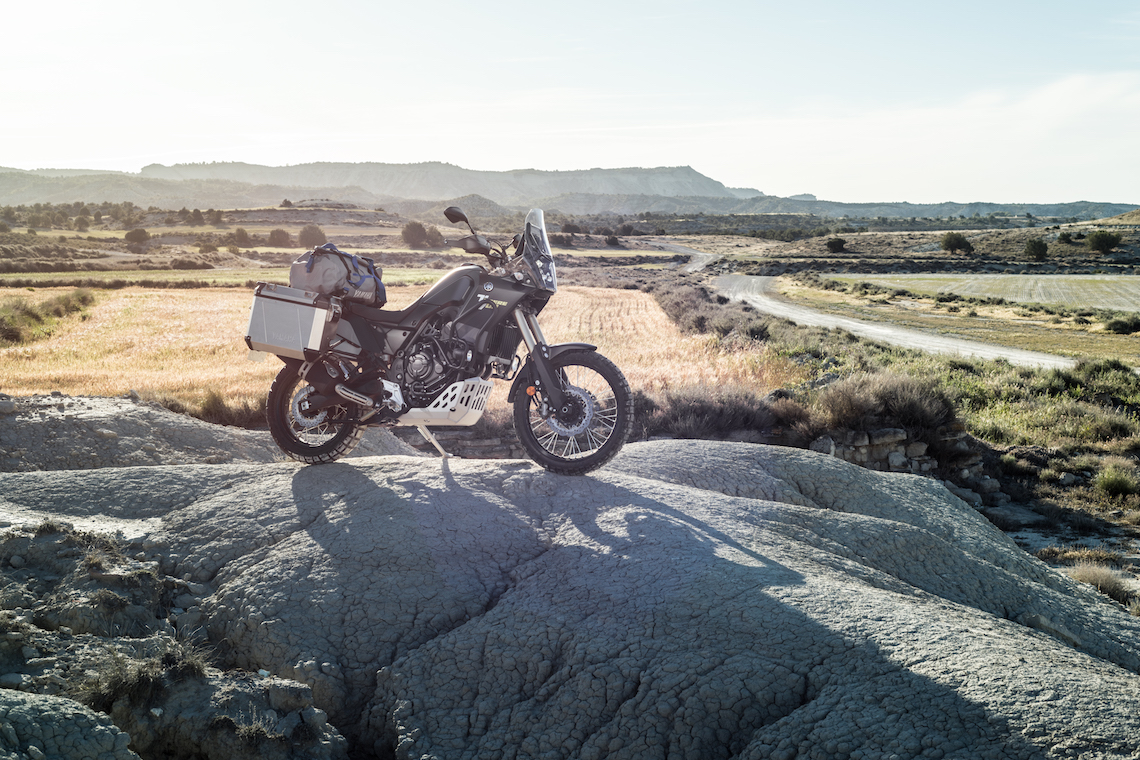
Plain fun
After lunch it was time to refuel at the local Repsol outlet. Its got a 16-litre tank with a generous 4.3-litre reserve that should be good for just over 200 miles, but maybe not if you are travelling at 120mph! Suitably brimmed, it was back out onto the plains again, but this time the fast tarmac was replaced with wide dirt trails that crisscrossed the landscape. A real opportunity to push the envelope on the handling and let the back end drift and slide about a bit.
While on other adventure bikes this type of activity would be controlled, monitored and generally managed by a host of computers, sensors and software, with the Ténéré it’s nothing more complicated than the rider and a throttle. It’s a shrewd move by Yamaha to go for the no-frills route and with such a positive and rewarding ride, there is never a point that you are yearning for the steadying hand of the ECU – you are just too busy enjoying yourself.
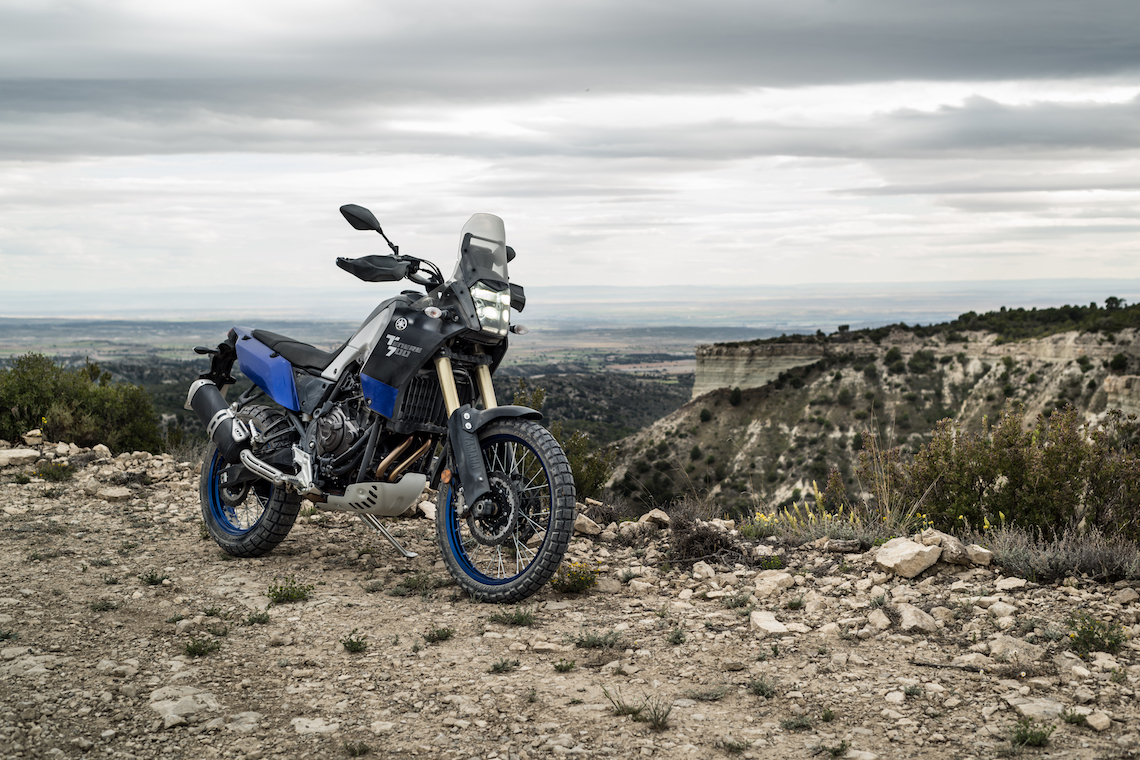
The seat is softer than it looks
Like the previous Ténéré, the new bike has a pretty comfortable seat that is softer than it looks in the front part where you will spend most of your time. Unlike the old one however, it’s a two-part construction, the rear part removable with the key to reveal a pitifully small storage area and provide access to remove the front part with the Allen key provided.
What it also hasn’t inherited is the previous deep-dish design and now with a much flatter profile you can move about far easier – essential on the dirt and particularly during a long day’s road ride. The optional rally seat is a one-piece design that, although is far better for off-piste fun, sacrifices a bit of comfort for that. So, is the standard seat all-day comfortable? Well we rode all day covering over 200 miles and weren’t uncomfortable, but in fairness we had stood up for a good part of the day!
As the sun slips towards the horizon, the day finishes after another epic stretch of mountain roads to reach our resort high in the Prades Mountains. After more than ten hours on the new Ténéré, the cold beers and barbeque could not be more welcome.

Slippery surface
The following morning, the first stretch of riding brought more deliciously twisty roads as we headed south towards Rasquerra where we picked up the off-road trails again. This time, the going was far more technical, initially following a series of switchback trails up the side of a mountain before reaching the top and plunging down through tight woodland trails and farmers tracks through olive groves and cherry orchards.
It was a wonderfully picturesque route, but with the slippery and unpredictable surface, it was head up and concentrate on your lines rather than admiring the view as we carved through the landscape. Luckily the Ténéré rewards your concentration with the sure-footedness of a particularly precise mountain goat and rarely puts a foot out of place. Man, this bike is good.
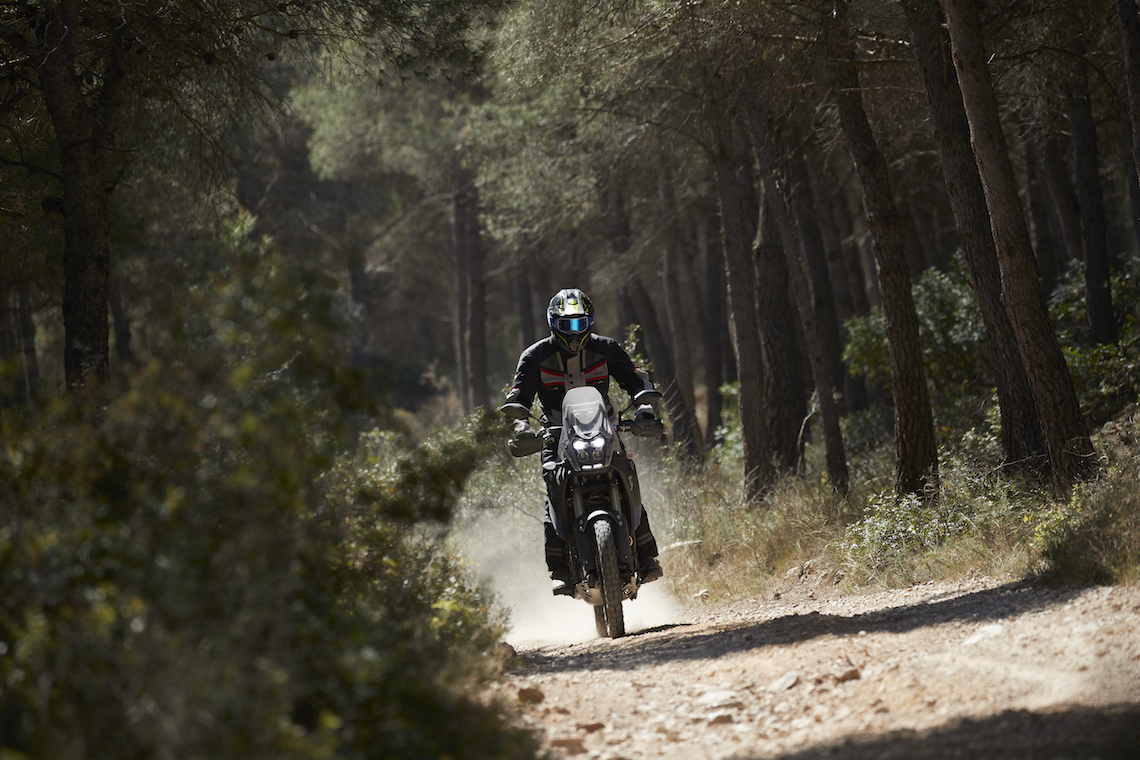
Back to base
With the best of the trails behind us, the road headed back towards Tortosa and the reluctant return of our Ténéré. The bike is so immediately likeable that we would happily have loaded up the luggage, picked up the southern leg of the TET and taken a leisurely two weeks to return home. Or perhaps taken the ferry over to Morocco and set the SatNav for Cape Town – both options are eminently achievable and tempting propositions for the T7.
So, is the new Ténéré going to be as popular as Yamaha clearly hopes? Is it good enough to succeed in such a crowded marketplace? Or has the protracted development done irreparable damage to the Ténéré’s future fortunes? Well, clearly the decision to release a prototype quite so early is probably not one Yamaha would make again.
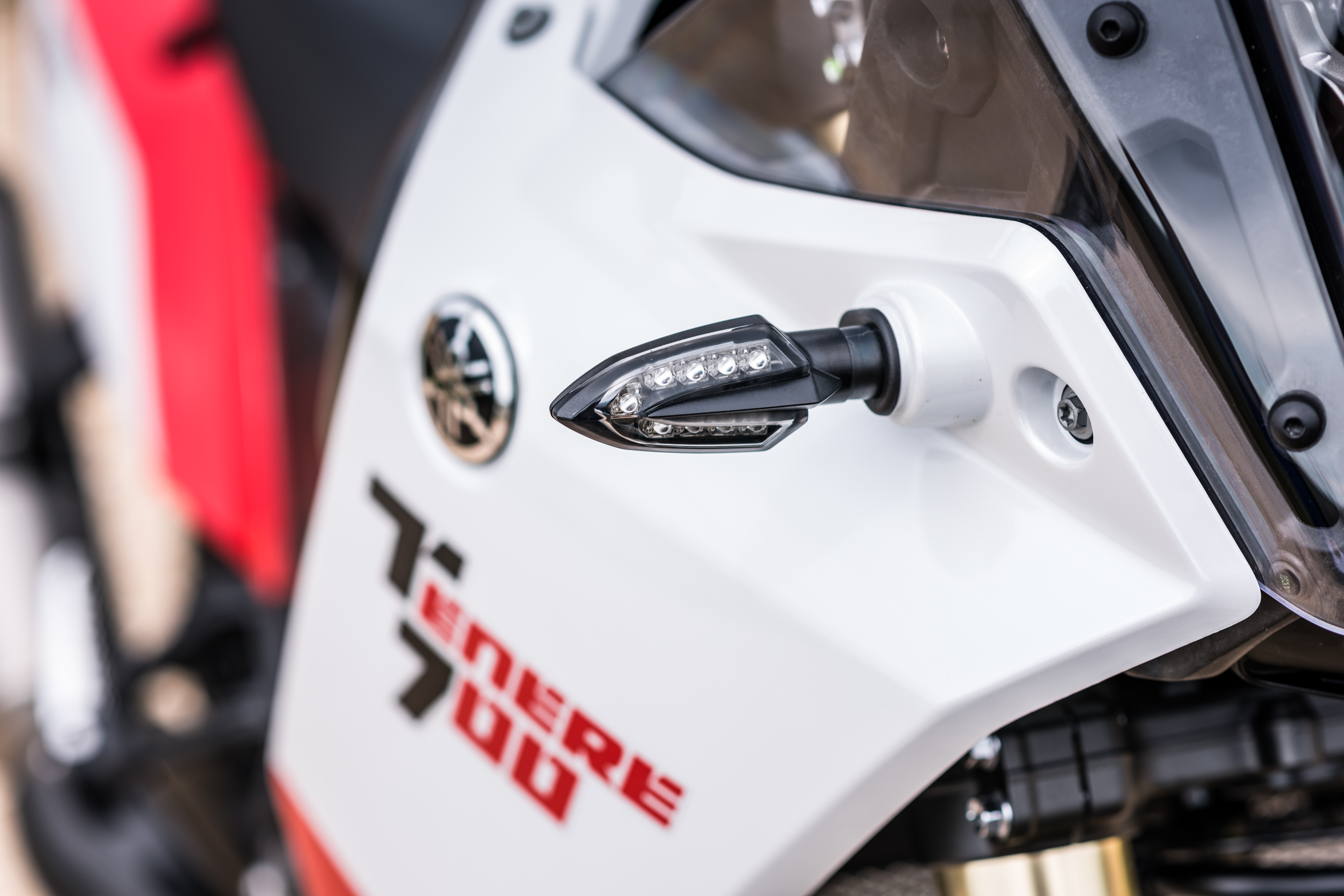
Overshadowed by frustration
In reality, two and a half years from prototype to production is not that long, but making the development process quite so public has frustrated the market rather than enthused it and it’s a shame that the launch of the next generation of the historic model has been overshadowed by this frustration.
But all that falls by the wayside once you ride the bike. It is easily one of the best set-up and most rewarding adventure bikes I have ridden. Yes, it’s not got the sophistication and technology of the KTM 790 adventure and 790 Adventure R or the off-road capability of the Husqvarna 701, nor has it got the presence and raw power of something like the BMW R 1250 GS Adventure. But to compare any of them misses the point of where this bike sits in the marketplace.
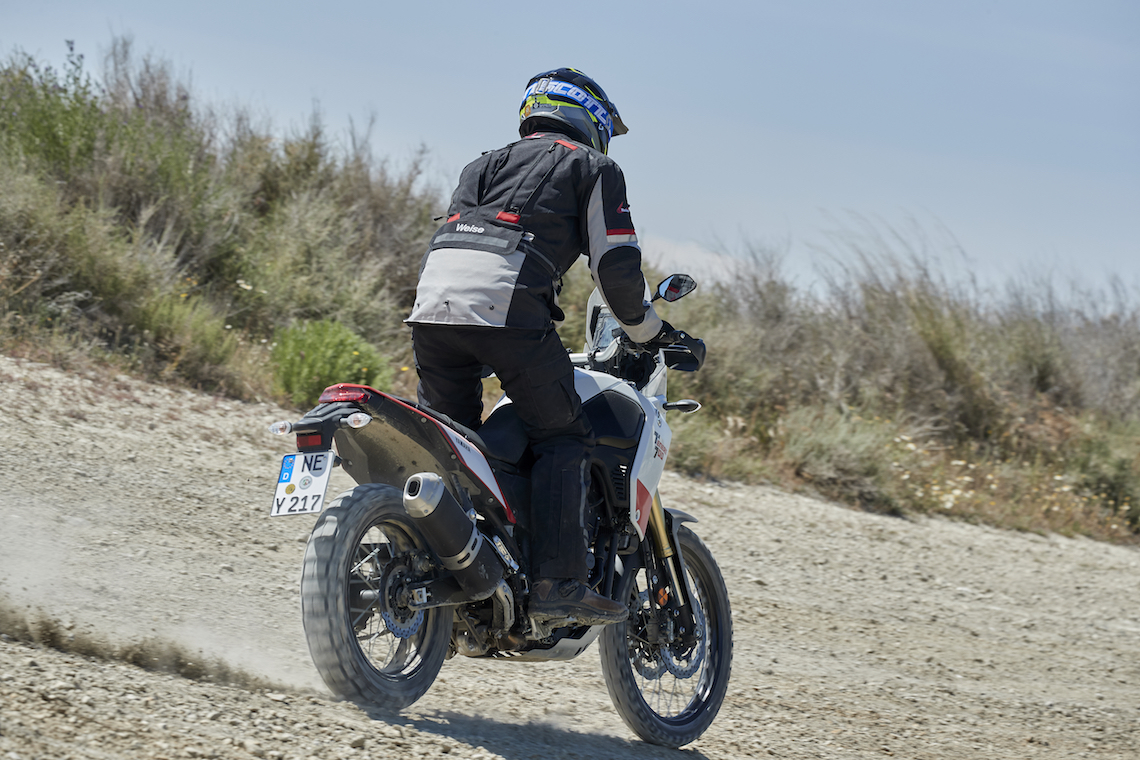
A class of its own
At £8,699 the Ténéré is in a class of its own – there is no other motorcycle that even remotely approaches it. You have to pay another £300 for the Husky and try getting a pillion to contemplate a long trip on that seat, let alone bring any luggage. The KTM 790 was touted as the bike’s natural competitor, but at £2,400 more for the Adventure and £3,300 for the R version, that’s a massive difference. And as for the BMW – you can buy two Ténéré’s for the same price…
At the press conference before the event, Yamaha had stressed its desire to honour the Ténéré’s heritage of almost 40 years and build the next horizon for the model. The team has achieved that and more, creating a truly impressive and enjoyable motorcycle that can hold its own against any bike within the adventure sector and beyond. The Ténéré is back!
ABR verdict – Yamaha Ténéré 700 review
As a commuter
If you wanted to use your Ténéré to fight your way through the traffic, the bike would be pretty damn good at it. With a relatively slim profile, high bars and mirrors and lively engine, the Ten would slice through the congestion with ease. And you’d have a blast doing it.
As a weekend tourer
As a way of brightening up your weekends, the Yamaha is going to tick the boxes too. The bike’s road manners are as good as it’s off-road capabilities, so slinging on your gear and setting of for two days of hooning about will become a regular pastime. The music choice – The Prodigy we reckon, perfect for spirited riding in the ‘shires.
As an off-roader
Yamaha has spent over two years to ensure that this bike was a capable off-roader, and they’ve done a great job. OK, in really sloppy conditions it might not be as joyful, but when the sun is out then the Ténéré will enjoy the dirt as much as you.
As a continental road tourer
Once you get yourself some of the luggage options, then the Ténéré will be a willing companion for trips across the channel and beyond. The tank is good for over 200 miles which is about as far as you want to go without a break, so get planning.
As an RTW overlander
The Ténéré has always been a contender as a RTW mule, and now it’s been vastly improved and refined, it will make a smart choice. It’s got great on and off-road capabilities, a simple yet powerful engine, cable operated clutch and throttle and good luggage carrying capacity. Are you the next Ewan or more of a Charley?
As a pillion carrier
While not exactly a deep and sumptuous seat for your passenger, it’s comfortable enough back there. The position isn’t too high, so they won’t be buffeted about, and the footpegs are in a sensible position to be all-day comfortable. Tell them to hold on…
Specs at a glance
Engine 2-cylinder, 4-stroke, liquid-cooled, DOHC, 4-valves
Capacity 689cc
Output 72bhp @ 9,000rpm
Torque 68Nm @ 6,500pm
suspension Front; KYB 43mm upside down, 210mm travel Rear; Sachs rear monoshock, 200mm travel
Brakes Front; 282mm twin-disc, Rear; Single 245mm disc
Tyres Front; 90/90 spoke wheels with Pirelli Scorpion Rally STR. Rear; 1150/70 spoke wheels with Pirelli Scorpion Rally STR
Weight 205kg wet
Tank capacity 16L
Seat height 880mm
Prices £8,699
Pack mentality
Aside from the standard model, we rode two different bikes that had been kitted out with accessory packs that can be ordered at purchase from your dealer or added subsequently.
The Rally Pack – as on the white bike in the pictures – gives you a one-piece grippy seat, Akropovic end can, chain guard and guide, radiator grill, slimline number plate holder, LED indicators and a rubber tank pad. The pack costs £1,486, cheaper than if you bought all the components separately.
The Explorer Pack – as on the Black bike – is more adventure focussed and includes lockable aluminium side cases with mounting frames, a mono seat rack that replaces the rear seat with a flat platform for luggage, a centre stand, a 33% thicker and larger sump guard and engine bars. This pack will cost you £1,690.
Both packs don’t necessarily include labour to fit all the parts but speak to your dealer nicely and get them to do it as part of the PDI.
Aside from the two packs, all the parts can be bought individually from Yamaha, as can an impressive array of other goodies from fog lights to lowering links. And as soon as the bikes hit the showrooms, expect an avalanche of trinkets and aftermarket accessories to become available for the Ténéré. This bike is going to be very, very popular.

